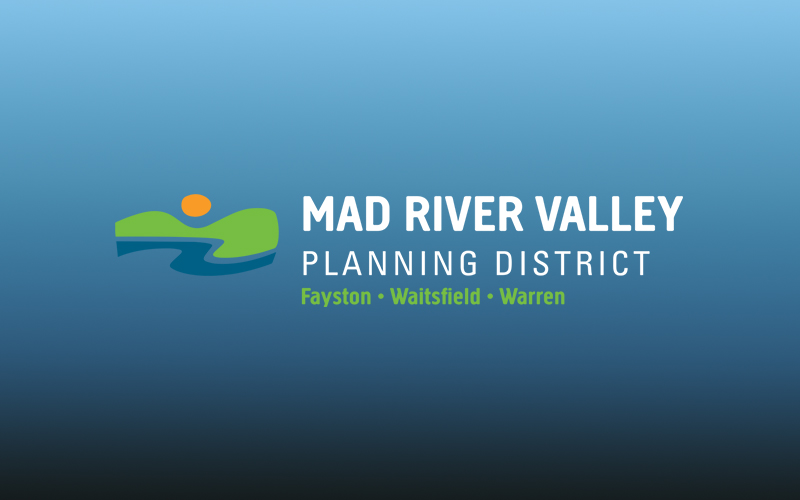Amy Tomasso recently joined the Mad River Valley Planning District (MRVPD) as a community planner. With many new people having moved to The Valley over the course of the COVID-19 pandemic, Tomasso took the time to answer some questions for those who are unfamiliar with the planning district and its work.
What is the MRVPD?
Tomasso: The Mad River Valley Planning District has the distinction of being the only tri-town planning entity in the state of Vermont and is tasked with the unique privilege of helping steward the physical, social, economic, fiscal, environmental, cultural and aesthetic well-being of its member towns (Fayston, Waitsfield and Warren) and their inhabitants.
But what does that mean, exactly? MRVPD takes a systems approach to regional planning, which means our work is integrated and interconnected across 10 major domains, from transportation to housing, recreation to climate/energy planning, placemaking to economic vitality. We work with various stakeholders including municipal governments, service and action organizations, appointed commissions, school boards, business entities and concerned citizens on issues related to land use planning. While the MRVPD is a two-person office consisting of executive director Joshua Schwartz and myself, we are guided by a steering committee with reps from the three member towns’ select boards and planning commissions, the Mad River Valley Chamber of Commerce, Sugarbush and Central Vermont Regional Planning Commission. MRVPD’s operations are funded by equal sums from the three member towns and Sugarbush Resort. Our office is located at the General Wait House.
MRVPD serves as a clearinghouse for relevant data, information, resources and support from grant writing to facilitating multifaceted community initiatives. Ultimately, what makes Fayston or Waitsfield or Warren stronger makes the whole Valley stronger -- and vice-versa -- and building off The Valley’s unified strength is one of the ways that the planning district approaches its work.
What major projects and initiatives has the MRVPD recently been involved in?
Tomasso: The work of the planning district can be seen across The Valley. We are constantly collaborating with and supporting our partner organizations, ensuring resources are focused on community-identified and relevant projects. You’ve probably seen the new trailhead kiosks welcoming and educating recreationists about The Valley’s extensive trail network, a Valley-wide wayfinding and mapping effort that MRVPD coordinated. In recent years, we’ve also played a role in re-activating the Mad River Valley Housing Coalition, leading the Mad River Valley Moves Active Transportation Plan, supporting the implementation of the Waitsfield Village West Sidewalk Project, planning for flood resilience post-Irene, collaborating with Green Mountain Transit on its Mad Bus service, and helping Valley recreation partners write the recently awarded VOREC grant, to name a few projects.
What are MRVPD’s major initiatives for the new fiscal year?
Tomasso: Over the next few weeks, we’ll be breaking down our 10 work domains through a series of articles -- illustrating that our planning efforts are as interconnected as The Valley itself. This week, we’ll start with areas of critical importance to all our planning and implementation work: transportation and climate/energy.
What about transportation?
Tomasso: We’re passionate about supporting efforts to increase sustainable and active transportation options, safety and improvements. According to the 2021 VT Climate Assessment, transportation is the largest source of greenhouse gas emissions in Vermont -- and our work towards making active transportation options available and accessible in The Valley is a great example of climate planning in action. Upcoming transportation projects for 2022-23 include facilitating the MRV Transportation Advisory Committee, supporting GMT’s winter bus service, implementing pedestrian safety improvements across The Valley, installing and analyzing pedestrian counters to get accurate data on sidewalk usage, and assisting VTrans and Waitsfield with a safety feasibility study of the VT 100/17 intersection.
Let’s talk about environment/climate
Tomasso: One of our tasks is to help the region reduce greenhouse gas emissions and adapt to the physical, environmental and social impacts of climate change and natural hazards. Planning for climate change is both an ethos to our approach and a backbone to all our work because sustainable decision-making makes the Valley stronger and making The Valley stronger will further mitigate the effects of climate change experienced here. MRVPD will be co-hosting two Valley-wide climate talks with Friends of the Mad River in 2022 to discuss how climate change is affecting our Valley, what we can do about it and how to apply VT’s state-wide Climate Assessment and Climate Action Plan at a local scale.
How can you get involved in MRVPD’s transportation and climate/energy work domains?
Tomasso: Curious about improving pedestrian safety in one of The Valley’s designated villages, or have an initiative that will make transportation more sustainable in the Valley? The MRV Transportation Advisory Committee meets the second Wednesday of every month at 3:30 p.m. on Zoom. Upcoming meetings are April 13 and May 11. Email
People can join MRVPD’s quarterly email newsletter at https://bit.ly/350oLaW to stay up-to-date on recent projects and community outreach.












